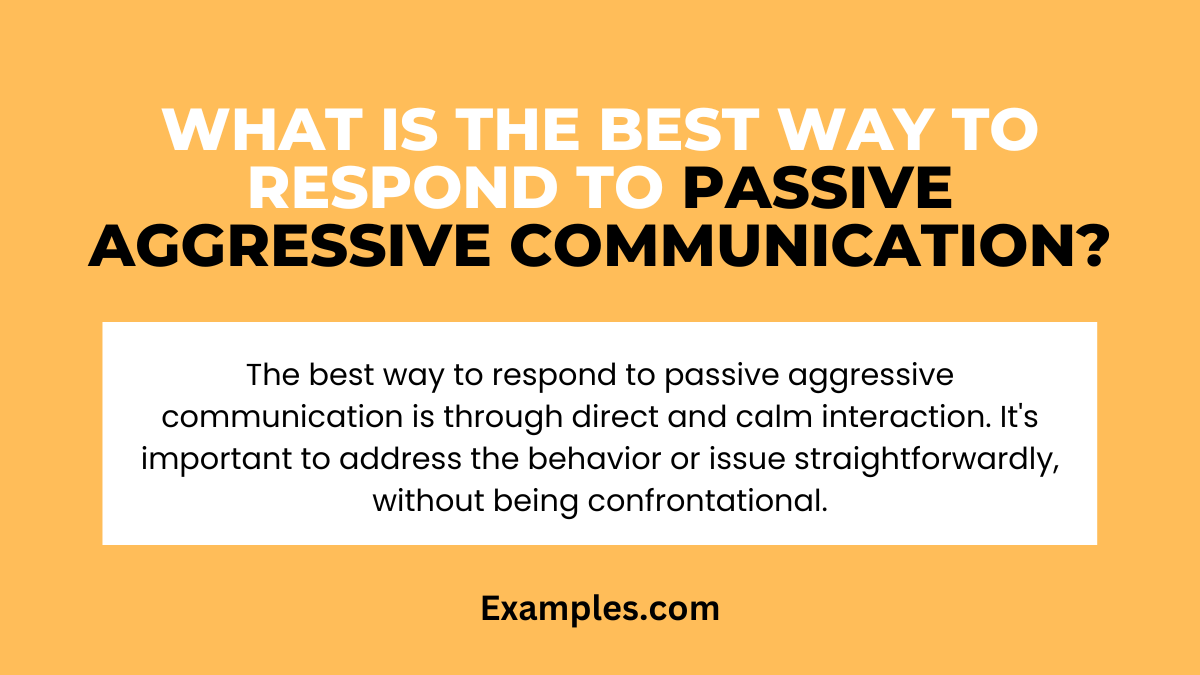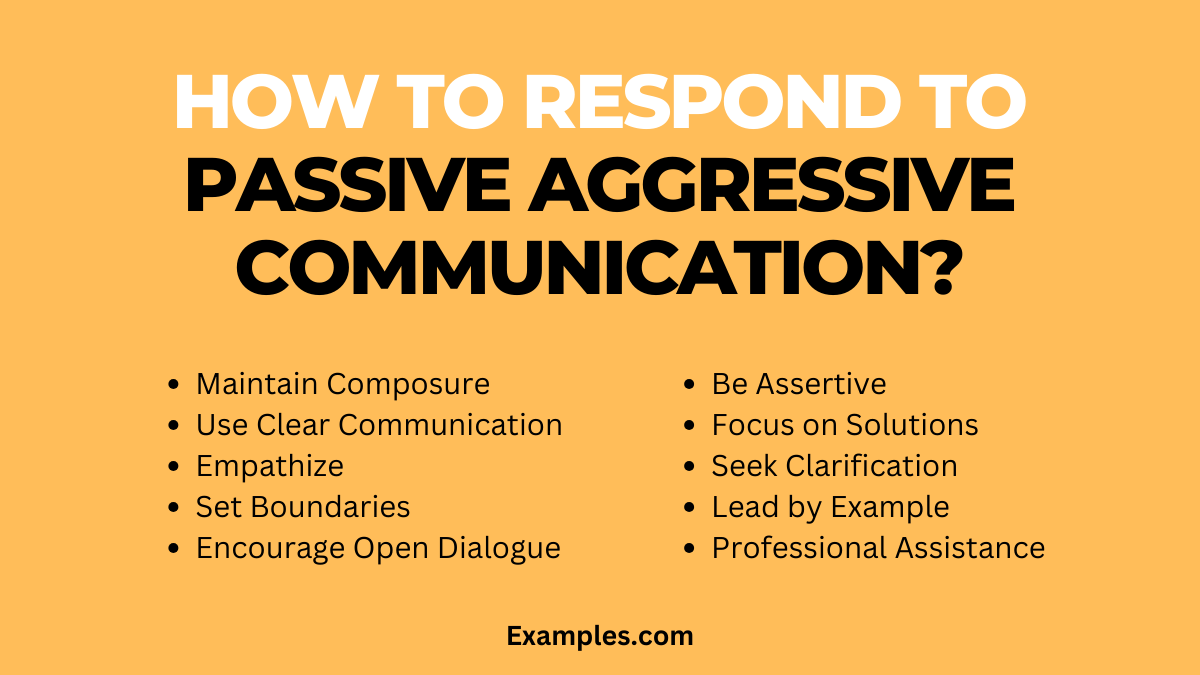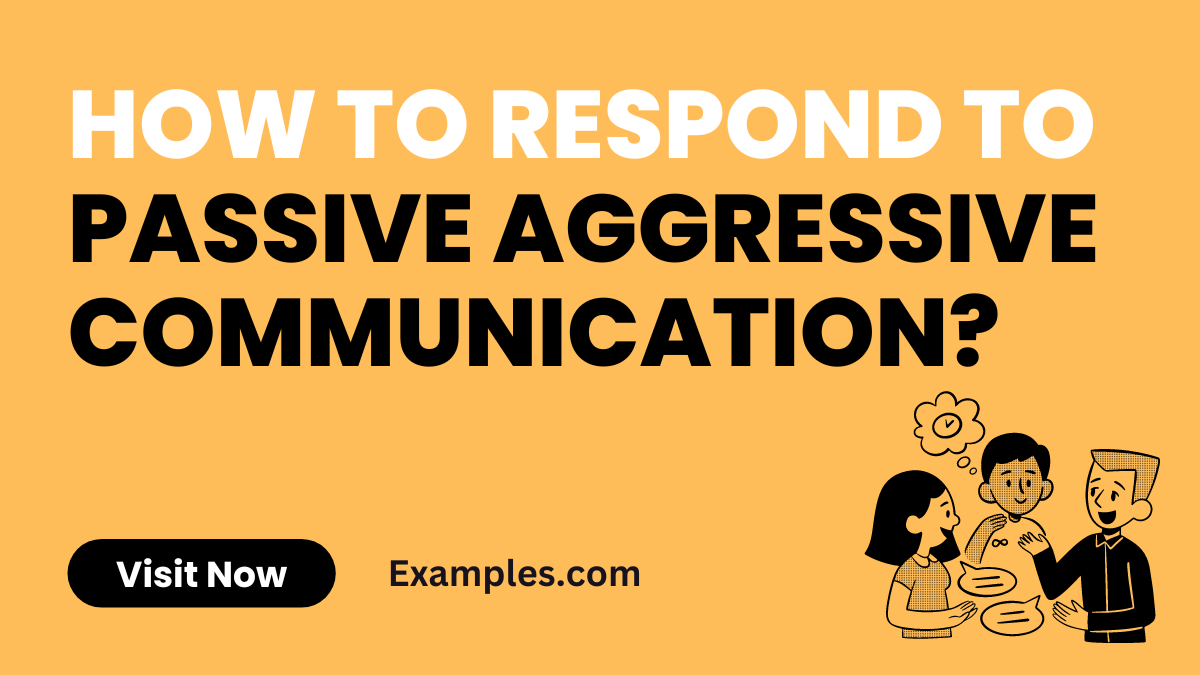How to Respond to Passive Aggressive Communication?
Responding to Passive Aggressive Communication can be challenging. This comprehensive guide offers practical strategies and real-life communication examples to help you navigate through indirect hostility. Whether in personal relationships or at the workplace, you’ll learn how to identify passive-aggressive signals and address them effectively. Enhance your communication skills by mastering the art of calm and assertive responses, turning potential conflicts into opportunities for understanding and cooperation.
What is the Best Way to Respond to a Passive Aggressive Communication?

The best way to respond to passive aggressive communication is through direct and calm interaction. It’s important to address the behavior or issue straightforwardly, without being confrontational. Using clear and empathetic language helps in addressing the underlying issues. Encouraging open and honest communication and setting clear boundaries are also key strategies. This approach helps in mitigating misunderstandings and fosters a healthier communication environment.
How to Respond to Passive Aggressive Communication?

To effectively respond to passive-aggressive communication, a thoughtful and strategic approach is essential:
- Maintain Composure: Keeping your composure is crucial. Reacting emotionally to passive-aggressive behavior often exacerbates the situation. Stay calm to maintain control of the conversation.
- Use Clear Communication: Practice clear and straightforward communication. Directly address the issues at hand, cutting through the ambiguity and indirectness typical of passive-aggressive behavior.
- Empathize: Try to understand the underlying reasons for their passive-aggressive communication. Empathy can defuse tension and lead to more productive interactions.
- Set Boundaries: It’s important to clearly state your boundaries. Let the passive-aggressive person know what is acceptable and what isn’t, and the consequences of overstepping these boundaries.
- Encourage Open Dialogue: Cultivate an environment where honest and direct communication is encouraged. This can help diminish the use of passive-aggressive tactics.
- Be Assertive: Assertively communicate your own feelings and needs. This doesn’t mean being aggressive, but rather expressing yourself clearly and respectfully.
- Focus on Solutions: Shift the conversation focus from the behavior itself to finding solutions to the underlying issues.
- Seek Clarification: If a statement or action by the passive-aggressive person is unclear, ask for clarification. This can help avoid misunderstandings and gives them a chance to express themselves more directly.
- Lead by Example: Model positive communication behavior. By demonstrating the kind of direct and respectful communication you prefer, you can set a standard for your interactions.
- Professional Assistance: In situations where internal efforts don’t lead to improvement, consider seeking help from a professional mediator or counselor.
Adopting these strategies can significantly improve interactions with passive-aggressive individuals, fostering a more open, respectful, and productive communication environment.
Examples for How to Respond to Passive Aggressive Communication
Responding effectively to passive aggressive communication involves a strategic and empathetic approach. It’s crucial to maintain composure, use clear and direct language, and understand the underlying emotions driving the passive aggression. Demonstrating empathy, setting boundaries, and focusing on constructive solutions can help in managing these interactions effectively. Encouraging open and honest dialogue while avoiding confrontation or accusatory language is key. This guide provides insight into navigating such complex communications and fostering healthier interactions.
- “I noticed your hesitation about the project. Can we discuss your concerns?” – Invites open discussion about hidden issues.
- “When you say ‘nothing’s wrong,’ but seem upset, it’s confusing. Let’s talk openly.” – Addresses discrepancies between words and emotions.
- “Your recent comments have been quite indirect. Can we clarify what you mean?” – Encourages clarity and directness in communication.
- “It seems like you’re not fully on board with the plan. What are your thoughts?” – Directly addresses perceived disagreement.
- “I feel there might be an issue you’re not expressing. I’m here to listen.” – Shows openness to understanding unspoken concerns.
- “When tasks are delayed, it impacts the team. How can we improve this?” – Connects behavior with its impact and seeks solutions.
- “I’ve noticed some sarcasm in our conversations. Let’s try to be more straightforward.” – Addresses the use of sarcasm and requests direct communication.
- “It seems like there’s more behind your ‘fine.’ Would you like to talk about it?” – Probes deeper into dismissive responses.
- “Your input is important. Please share your honest opinion.” – Encourages honest and direct feedback.
- “Let’s address any concerns directly to work more effectively.” – Suggests a direct approach to resolving issues.
How to Respond to Passive Aggressive Comments?
Responding to passive aggressive behavior involves several key strategies:
- Maintain a Neutral Tone: Keeping your tone calm and neutral is crucial. Avoid responding with similar hostility or passive aggression, as this can exacerbate the situation.
- Clarify Intentions: When faced with ambiguous comments, ask for clarification. This can help uncover the true intent behind their words and mitigate misunderstandings.
- Use Direct Communication: Employ clear, straightforward language in your responses. Direct communication can help counter passive aggressive tendencies.
- Express Your Feelings: Utilize ‘I’ statements to express how their behavior affects you. This personalizes your response without being accusatory.
- Seek Solutions: Focus on constructive solutions instead of dwelling on the passive aggressive nature of their comments. This keeps the conversation forward-looking.
- Avoid Escalation: Be mindful not to escalate the situation with your responses. Steering clear of confrontational or accusatory language is key.
By implementing these strategies, you can effectively respond to passive aggressive behavior in a way that is respectful, clear, and conducive to resolving underlying issues.
Examples for How to Respond to Passive Aggressive Comments
Responding to passive-aggressive comments involves addressing the underlying issue while maintaining a composed demeanor. It’s important to recognize the indirect negativity and address it with direct, calm communication. Empathy and clarity in your response can help defuse the situation and encourage more straightforward interaction. The goal is to navigate the conversation towards a more positive and open dialogue, reducing misunderstandings and hidden tensions.
- “I sense some sarcasm in your comment. Can we discuss what’s really bothering you?” – Directly addresses the sarcasm and invites open discussion.
- “Your remark seemed a bit indirect. Let’s talk openly about any concerns.” – Encourages clarity and direct communication.
- “I’m not sure I understand the tone of your email. Could we clarify your points?” – Seeks to understand the true intention behind written communication.
- “I feel there’s an underlying issue here. It’s important for me to understand your perspective.” – Expresses desire to understand and resolve any hidden issues.
- “When you say things like that, it’s hard to understand your actual concern. Let’s be clear about what you’re saying.” – Encourages clear and direct expression of thoughts.
How to Respond to Passive Aggressive Behavior?
Responding to passive aggressive behavior involves a strategic approach that encourages open communication:
- Acknowledge the Behavior: Recognizing passive aggressive behavior as it happens is the first step in addressing it. This involves being aware of indirect expressions of discontent or resistance.
- Clarify Intentions: If you encounter ambiguous statements, ask for clarification. This helps in understanding the true message behind the words.
- Maintain Professionalism: In professional settings, it’s crucial to keep interactions respectful and formal, even when addressing passive aggression.
- Encourage Directness: Prompt the individual to communicate openly. Encouraging directness helps in reducing indirect or evasive communication tactics.
- Demonstrate Understanding: Show empathy towards their feelings. Understanding that there might be deeper emotions driving the behavior can aid in resolving the underlying issues.
- Practice Patience: Changing behavioral patterns, especially passive aggressive ones, takes time. Be patient with the process.
This approach promotes a healthier and more transparent communication environment, reducing the impact of passive aggressive behavior.
Examples for How to Respond to Passive Aggressive Behavior
Effectively responding to passive-aggressive behavior requires a thoughtful and assertive approach. It involves acknowledging the behavior, maintaining your composure, and encouraging open and honest communication. Directly addressing the underlying issues in a non-confrontational manner can help break the cycle of passive aggression. The key is to create an environment of mutual respect where both parties feel heard and understood.
- “I noticed you agreed but seemed reluctant. Can we talk about any reservations you have?” – Addresses reluctance and invites honest communication.
- “It seems like there’s more behind your actions. I’m here to discuss any concerns openly.” – Encourages discussion about unspoken issues.
- “Your recent behavior suggests you might be upset. Let’s address this directly.” – Directly addresses observed behavior and proposes open discussion.
- “I feel there’s a disconnect between what you say and what you do. Can we clarify your intentions?” – Points out inconsistencies and seeks clarity.
- “When you avoid discussing the problem, it makes resolution difficult. Let’s try to talk it through.” – Emphasizes the importance of direct communication for problem-solving.
Tips for Handling Response to Passive Aggressive Communication
Responding effectively to passive-aggressive communication requires a nuanced approach that balances assertiveness with empathy. Here are some strategies:
- Understanding the Behavior: Recognize that passive-aggressive communication often stems from an inability to express emotions directly. This understanding can inform your response.
- Address the Underlying Issue: Try to identify and address the root cause of the passive-aggressive behavior.
- Communicate Assertively: Be clear and assertive in your responses. Assertive communication involves expressing your thoughts and feelings honestly and respectfully.
- Use Reflective Listening: This technique involves paraphrasing and summarizing what the other person has said to ensure you have understood their message correctly.
- Provide Positive Reinforcement: When the individual communicates in a more direct and open manner, acknowledge and reinforce this behavior.
- Seek Professional Advice: If the passive-aggressive behavior is affecting your mental health or well-being, consider seeking advice from a counselor or therapist.
Employing these tactics can make interactions with a passive-aggressive person more manageable and less stressful.
In conclusion, effectively responding to passive-aggressive communication requires patience, understanding, and assertiveness. It’s vital to maintain composure, address the underlying issues, and communicate openly. By doing so, you can turn difficult interactions into constructive conversations, fostering healthier relationships and a more positive communication environment. This guide aims to empower you with the tools and strategies to navigate through indirect hostility, enhancing your interpersonal skills in various settings.



